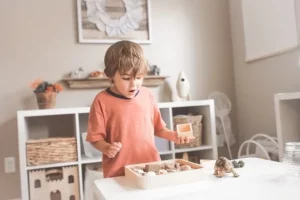As the schools reopens this week, we often hear parents and teachers looking for an easier way of helping children with transitions – be it from homes to cars, into classrooms, between classes or back to home.
- As a therapist, have you had a very productive session with a child, only to watch them run around the waiting room after the session has ended and you are trying to talk to the parents?
- As a teacher, have you had a child who is handling himself “well” during outdoor/physical activities such as recess or PE sessions (where loud voices, touching, bumping and running are permitted) but who would continue to bring this behavior into the class where it is not permitted?
- As a parent, do you find that you’re sometimes struggling because a high-demand activity such as the morning routine before a new school term has gone well because you have prepared your child for it, while a relatively routine activity such as getting into the car afterwards has not?
We are always looking at “getting ready” for our children with sensory processing challenges. As therapists, while preparing for our sessions, we have ready what each child needs in order to be at an optimal place for sensory-motor learning. As parents, we have learned what works for our child to be at their best, depending on the upcoming task or demand. This is termed a front loading approach where we prepare the environment in an activity to encourage successful participation for the child.
Everyone is focused on transitions, and how difficult they can be for these children. As a therapist as well as a parent, I think we need to reflect further on the disengagement from an activity. Though the behaviours are observed during the transitions, I believe the source of the challenge is a child who has not truly disengaged from the activity occurring first. We see this at home often with our two year old, Tanay. Tanay is a great kid who works well with meal time routines, bed time routines etc. However, we often see meltdowns when it is time to go to bed, though he is fine once we reach his room and start the routine of pajamas, story, song etc. The issue here is that he is so engaged in the activity before bedtime, that he doesn’t want to end his success/interaction there.
Going back the questions asked to therapists, teachers and parents earlier in this article, if we relook the transition phase in each of the scenarios, it appears as though the child has not disengaged from one activity before being moved onto another, making transitions a challenge.
So what can we do to help a child disengage from the last activity? There have been suggestions to use readily available tools such as timers etc. Timers (visual/auditory or verbal reminders telling a child so many minutes left) let the child know that closure and transition is imminent. Yet I believe children with Sensory Processing Disorder (SPD) and other sensory processing challenges need more than these tools to prepare their systems to stop an activity/sensory set.
Perhaps if our sensory diet is front-loaded and back-loaded, the transition will take care of itself. All of us recommend and utilize transition tools, such as fidgets and heavy work, e.g. carrying a backpack when going from one classroom to another. But when inserted in the transition phase, the child is simultaneously expected to perform other new actions that have very different sensory demands from the activity he has just completed; an activity which his central nervous system is still very much engaged in. In contrast, if we were to add another sensory diet phase during the later stages of an activity, and prior to its completion, it would ready the nervous system for a shift-change. The body can begin disengagement from the activity, making our transitional tools more effective, so the child can process the new demands expected of him during the transition. This will require that we, as parents and providers, also disengage ourselves, our tasks, and our conversations before the time is technically “up,” which can be difficult; particularly if the child appears successful in the activity.
I’ll be trying this out over the next few weeks, and I invite you to do so as well. I’d love to hear from you about how it’s going.












